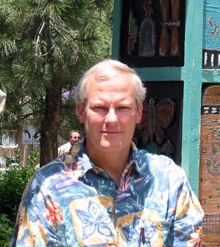Richard Kemp
Professor Emeritus

Education
- B.S. in Chemistry, 1978, Texas Tech University
- Ph.D.in Chemistry, 1982, University of Texas
Research
Dr. Richard Kemp has a dual appointment as a Professor of Chemistry at UNM and as a Principal Member of the Scientific Staff at Sandia National Laboratories. As such, the research topics under study in our group reflect the diverse interests of both organizations. However, one common theme found in all of the work ongoing in our laboratory is synthetic inorganic and organometallic chemistry. In one major thrust area, our research group is working to understand the activation of carbon dioxide (CO2) using main group metal amido complexes in order to eventually convert these metal carbamates into organic molecules such as isocyanates or carbodiimides, useful in the chemical industry.
In a related area, we are also trying to chemically "sequester" CO2 into stable complexes under mild conditions to form new compounds or ligands that contain large amounts of CO2. Highly electron-deficient s and p block metals are required to activate the CO2 at conditions of room temperature and pressure. A longer-term project of interest to both UNM and Sandia is the conversion of CO2 into other useful molecules, such as dimethylcarbonate (DMC) or methanol. The overall concept is to "re-use" CO2 as a transportation fuel or fuel additive in order to help mitigate CO2 release and global warming. A source of reductive power – such as H2 or electrons – must be provided to re-energize the CO2. We are examining nano-sized, Cu-based materials and electrocatalysts to aid in this conversion.
In another major area of research, we are collaborating with Professor Karen Goldberg's group at the University of Washington to examine the selective oxidation of olefins using transition metal hydroperoxide complexes. We have proposed a "green" catalytic cycle that uses O2 gas as the oxidant. The catalysts under examination are homogeneous, generally mid-to-late transition metals with chelating ligands attached. We have recently demonstrated the first well-characterized insertion of O2 into a Pd-H bond. The ultimate goal of this work is to prepare epoxides or other oxygenated species that are of interest to industry. Finally, we are also interested in the invention and development of new ligand moieties.
We have been active in developing new -bonding ligands that are unique due to their cationic nature. As well, P-C and P-N containing ligands as replacements for the commonly-used cyclopentadienyl and related ligands are also under development. More information on these projects, and on our group members, can be found in the Kemp Group website. We are a highly-collaborative group, both internally within UNM and Sandia, as well as externally with groups around the world. These collaborators are also highlighted on our group's webpage.
Selected Publications
- M.C. Denney, N.A. Smythe, K.L. Cetto, M. Denney, R.A. Kemp, and K.I. Goldberg, "Insertion of Molecular Oxygen into a Palladium(II) Hydride Bond", J. Amer. Chem. Soc., 128, 2508 (2006).
- J.M. Keith, R.P Muller, R.A. Kemp, K.I. Goldberg, W.A. Goddard III, and J. Oxgaard, "Mechanism of Direct Molecular Insertion in a Palladium(II) Hydride Bond", Inorg. Chem, 45, 9631 (2006).
- Y. Tang, A.M. Felix, V.W. Manner, L.N. Zakharov, A.L. Rheingold, B. Moasser, and R.A. Kemp, "Synthesis and Characterization of Divalent Main Group Diamides and Reactions with CO2", ACS Symp. Ser., 917, 409 (2006).
- Z. Yinghuai, S.C. Peng, and R.A. Kemp, "Supported Ultra Small Palladium on Magnetic Nanoparticles Used as Catalysts for Suzuki Cross-Coupling and Heck Reactions", Advanced Synthesis and Catalysis, 349, 1917 (2007).
- D.A. Dickie, M.V. Parkes, and R.A. Kemp, "Insertion of Carbon Dioxide Into Main Group Complexes: Unprecedented Reaction to Form the [N(CO2)3]3- Ligand", Angew. Chem. Int. Ed., 47, 9955 (2008).
- G. Page, A.M. Felix, D.A. Dickie, L. Chen, and R.A. Kemp, "Yellow and Blue Make Green: The Importance of Stoichiometry in the Reaction of 1,4-bis(2,6-diisopropylphenyl)-1,4,-diazabutadiene with Dimethylgallium Chloride", Main Group Chem., 9, 11 (2010) (cover article highlighted in C&EN, April 20, 2009 issue)
- C.A. Stewart, D.A. Dickie, M.V. Parkes, J.A. Saria, and R.A. Kemp, "Reactivity of Bis(2,2,5,5-tetramethyl-2,5-disila-1-azacyclopent-1-yl)tin with CO2, OCS, and CS2 and Comparison to That of Bis[bis(trimethylsilyl)amido]tin", Inorg. Chem., 49, 11133 (2010).
- A. Mrutu, D.A. Dickie, K.I. Goldberg, and R.A. Kemp, "A Unique Three-Dimensional Coordination Cluster Based on a Silver Carbene Complex", Inorg. Chem., 50, 2729 (2011).
- G.R. Fulmer, W. Kaminsky, R.A. Kemp, and K.I. Goldberg, "Syntheses and Characterization of Palladium Complexes with Hemilabile "PCO" Ligands", Organometallics, 30, 1627 (2011).
- R. Lansing, K.I. Goldberg, and R.A. Kemp, "Unsymmetrical RPNPR' Pincer Ligands and Their Group 10 Complexes", Dalton Trans., 40, 8950 (2011).
- C.A. Stewart, D.A. Dickie, B. Moasser, and R.A. Kemp, "Reactions of CO2 and Related Heterollenes with CF3-Substituted Aromatic Silylamines of Tin", Polyhedron, 32, 14 (2012).
- C.A. Stewart, D.A. Dickie, Y. Tang, and R.A. Kemp, "Insertion Reactions of CO2, OCS, and CS2 Into the Sn-N bonds of (Me2N)2Sn: NMR and X-ray Structural Characterization of the Products", Inorg. Chim. Acta, 376, 73 (2011).
- G.R. Fulmer, A.N. Herndon, R.A. Kemp, and K.I. Goldberg, "Hydrogenolysis of Pd(II)-OR Complexes", J. Am. Chem. Soc., 133, 17713 (2011).
- D.A. Dickie, Eric N. Coker, and R.A. Kemp, "Formation of a Reversible, Intramolecular Main Group Metal-CO2 Adduct", Inorg. Chem., 50, 11288 (2011).
- D.A. Dickie, K.B. Gislason, and R.A. Kemp, "Formation of Phosphino-substituted Isocyanate by Reaction of CO2 with Group 2 Complexes Based on the (Me3Si)(i-Pr2P)NH Ligand", Inorg. Chem., 51, 1162 (2012).
